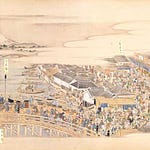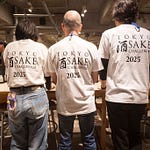Welcome to Issue #117 of SIN.
Could this be the issue where we get to the end without mentioning the weather?
No.
But let’s not drag on about it. There’s other things to focus on. Such as the Olympics!
That time of year when the world’s greatest athletes who have dedicated their lives to their sport, gather to compete for gold.
But what does that have to do with sake?
Well, it highlights a significant difference when compared to sake competitions in that the winners of Olympic (and other sporting events) are objectively the best in their field. Sure, there might be slip ups and a little bit of “luck on the day”, but if a sprinter runs faster than everyone else in the race, that sprinter is objectively the fastest (re. best) in that competition. You can’t say, “well, I still think the guy that came fifth is faster.”
I mean you could, but you’d be wrong.
As we’ve touched on many times in the past, sake competitions (and many others of similar ilk) do not operate this way. And as much as the judges in any given competition may be qualified and experienced enough to determine what makes a sake flawless in its execution, this is all judged by one’s palate and not by an independent mechanism, such as a clock in a sprint.
So when it comes to sake, if you still think the sake that came fifth, or even lower, in any competition is the best, you can be right.
But best not to overthink it, just drink it.
And now for the news…
Kochi Is Milling Again
Kochi- In issue #85 of April last year SIN reported on the closure of Kochi Prefecture’s sole rice milling plant, JA Kochi. The business closed due to financial strains which left the business unable to renew its deteriorating facilities.
JA Kochi was established in 1996 and had been milling approximately 850 tons of rice per year for 13 of Kochi Prefecture’s 18 breweries. As the time approached to upgrade the plant’s machinery and facilities, JA Kochi approached the Kochi Brewer’s Association to discuss a financial arrangement which would afford the company the capital to complete the upgrades. Unfortunately, an agreement couldn’t be reached and JA Kochi’s hand was forced, bringing about the closure of the milling plant.
With the announcement of JA Kochi’s closure came cause for concern for breweries on the island of Shikoku, with fears that outsourcing milling to facilities located on the mainland would lead to an increase in costs and a subsequent rise in retail prices.
However, it appears luck has turned for JA Kochi, which reopened for business in April this year after Katsuhiko Morishita, the CEO of Kochi Bank read about the closure in the local newspaper. Feeling the situation was resolvable, Morishita implored the Kochi Prefectural Government to assist in formulating a recovery process. With the powerhouse team of the government, Kochi Bank and the assistance of some local regional trading companies, JA Kochi has been revived as Kochi Sake Rice Milling Factory (Kochi Sakamai Seimai Kōjo).
Once the machinery is upgraded, the facility will be ready for operation from August 2024.
JG: Clearly the entire prefectural sake industry was in a bind, and it looks like they dodged a bullet. Interestingly, this was also announced on the web page of the seimaiki (rice milling machine ) industry leader, Satake, which is in Hiroshima. So it seems as if the new milling machines will be Satake machines. However, this was not clearly stated anywhere; not sure why not.
Battling The Elements
Nagano- In SIN#100 we reported on the progress being made in Hiroshima in developing a new sake rice called Moeibuki, which has been designed to be more resistant to the extreme heat brought about due to climate change. High levels of heat from global warming results in lower yields and poor quality of most agricultural products, and rice is no exception.
Now, as part of a project ten years in the making, Nagano Prefecture is joining Hiroshima with the development of not just one, but two varieties of local, high-temperature resistant rice.
The two strains show different characteristics in line with their differing heritage. Shinkō Sake No. 555, also known as Yamamizuki was developed by crossing Shinkō Sake No. 516 and Mineharuka, while Shinkō Sake No. 557 AKA Yumemi Nishiki boasts parentage from Yamada Nishiki and Mie Sake No. 20.
Both varieties have shown through testing to be suitable to ginjō-style of brewing due to their resistance to breaking under high-milling conditions and have demonstrated good solubility - an ongoing problem for a number of varieties grown in extreme heat.
Brewing trials are still ongoing, however the first releases of sake made with the new rice varieties have already hit the market with offerings from Daishinshu, Senjō and Nakazen.
Listen to this episode with a 7-day free trial
Subscribe to Sake Industry News to listen to this post and get 7 days of free access to the full post archives.












